General Controls Select Edit, Preferences, General to open the Preferences box to the General page (in Mac OS X, select Photoshop, Preferences, General). You use this page of the Preferences box to control interpolation, the Color Picker option, and a number of other general application parameters. 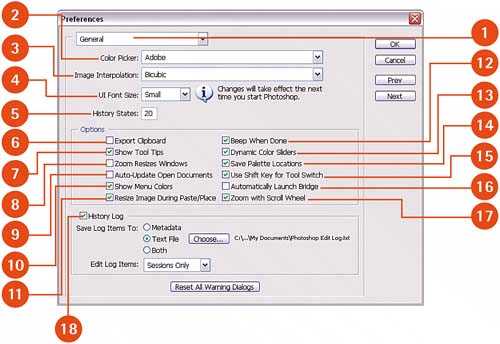  Preferences Title pop-up menu: Click the arrow to display a list of other pages in the Preferences box; select an option to open that page. Also, the Next and Prev buttons jump forward or backward to the choices in this list. Preferences Title pop-up menu: Click the arrow to display a list of other pages in the Preferences box; select an option to open that page. Also, the Next and Prev buttons jump forward or backward to the choices in this list.
 Color Picker pop-up menu: Click the arrow to display a list of Color Picker options; select the Adobe or Apple/Windows Color Picker. Color Picker pop-up menu: Click the arrow to display a list of Color Picker options; select the Adobe or Apple/Windows Color Picker.
 Image Interpolation pop-up menu: Click the arrow to display a list of interpolation options. Select Nearest Neighbor, Bilinear, Bicubic, Bicubic Smoother, or Bicubic Sharper. In most cases, use Bicubic Smoother when enlarging an image and use Bicubic Sharper when reducing or downsampling. Each image is different, however, so experiment for best results. Image Interpolation pop-up menu: Click the arrow to display a list of interpolation options. Select Nearest Neighbor, Bilinear, Bicubic, Bicubic Smoother, or Bicubic Sharper. In most cases, use Bicubic Smoother when enlarging an image and use Bicubic Sharper when reducing or downsampling. Each image is different, however, so experiment for best results.
 UI Font Size: This option allows control over the size of text for user interface items such as the text that appears on the tabs of palettes. By default it is set to Small. UI Font Size: This option allows control over the size of text for user interface items such as the text that appears on the tabs of palettes. By default it is set to Small.
 History States: By default this number is set to 20, which means Photoshop stores (via the History palette) the last 20 steps performed on an image. A larger number gives you greater control in how many steps you can go back (if needed), but the tradeoff is that it also requires more memory to store that information in the History palette. History States: By default this number is set to 20, which means Photoshop stores (via the History palette) the last 20 steps performed on an image. A larger number gives you greater control in how many steps you can go back (if needed), but the tradeoff is that it also requires more memory to store that information in the History palette.
 Export Clipboard check box: This option attempts to export the current Clipboard contents when Photoshop is closed. Leave this option disabled because it slows the shutdown process and because the exported format is almost always incompatible. Export Clipboard check box: This option attempts to export the current Clipboard contents when Photoshop is closed. Leave this option disabled because it slows the shutdown process and because the exported format is almost always incompatible.
 Show Tool Tips check box: Activatesthe pop-up tool descriptions when you hover the cursor over the interface elements. Show Tool Tips check box: Activatesthe pop-up tool descriptions when you hover the cursor over the interface elements.
 Zoom Resizes Windows check box: Resizes image windows when zooming in and out of the image from the keyboard. Zoom Resizes Windows check box: Resizes image windows when zooming in and out of the image from the keyboard.
 Auto-Update Open Documents check box: Updates open documents automatically. Auto-Update Open Documents check box: Updates open documents automatically.
 Show Menu Colors check box: Enables the color display for custom menus. Show Menu Colors check box: Enables the color display for custom menus.
 Resize Image During Paste/Place check box: Determines whether to resize pasted or placed images that are larger than the Photoshop document. Resize Image During Paste/Place check box: Determines whether to resize pasted or placed images that are larger than the Photoshop document.
 Beep when Done check box: Emits an audible beep when a task is complete. Beep when Done check box: Emits an audible beep when a task is complete.
 Dynamic Color Sliders check box: Updates the current color selections in the Color palette in real time as the sliders are adjusted. Disable this check box for a slight performance increase. Dynamic Color Sliders check box: Updates the current color selections in the Color palette in real time as the sliders are adjusted. Disable this check box for a slight performance increase.
 Save Palette Locations check box: Reopens palettes in the same place and at the same size as they were when they were closed, or when Photoshop is closed. Save Palette Locations check box: Reopens palettes in the same place and at the same size as they were when they were closed, or when Photoshop is closed.
 Use Shift Key for Tool Switch check box: Enables the use of the Shift key along with the letter key assigned to the tool to toggle tool selections within a group of tools. When unchecked, simply repeatedly press the letter key assigned to the tool to toggle between the grouped tool selections. Use Shift Key for Tool Switch check box: Enables the use of the Shift key along with the letter key assigned to the tool to toggle tool selections within a group of tools. When unchecked, simply repeatedly press the letter key assigned to the tool to toggle between the grouped tool selections.
 Automatically Launch Bridge check box: Automatically launches Bridge in the background whenever Photoshop is opened. Automatically Launch Bridge check box: Automatically launches Bridge in the background whenever Photoshop is opened.
 Zoom with Scroll Wheel check box: This determines whether scrolling or zooming is the default action for a mouse with a scroll wheel option. Zoom with Scroll Wheel check box: This determines whether scrolling or zooming is the default action for a mouse with a scroll wheel option.
 History Log check box: Enable this check box to generate an ongoing log of activities executed within each session of Photoshop. History Log check box: Enable this check box to generate an ongoing log of activities executed within each session of Photoshop.
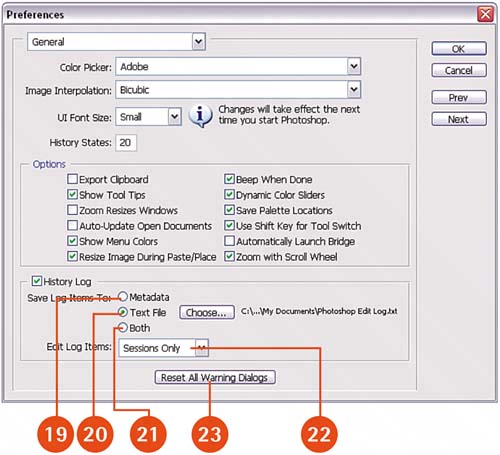  Save Log Items to Metadata: Saves the history log in XML-base metadata format within the file. Save Log Items to Metadata: Saves the history log in XML-base metadata format within the file.
 Save Log Items to Text File: Saves the history log as a generic text file. Click the Choose button to designate the save location for the history log text file. Click and navigate to the desired destination folder. Save Log Items to Text File: Saves the history log as a generic text file. Click the Choose button to designate the save location for the history log text file. Click and navigate to the desired destination folder.
 Save Log Items to Both: Creates a history log record in both metadata and generic text formats. Save Log Items to Both: Creates a history log record in both metadata and generic text formats.
 Edit Log Items pop-up menu: Select from Concise, Detailed, and Sessions Only history log formats. Concise shows the opening and closing of files and of the application itself, plus the edits recorded in the History palette. Detailed shows everything Concise does, plus every edit used and the file paths. Sessions Only records only the start date and time, with no editing data stored. Edit Log Items pop-up menu: Select from Concise, Detailed, and Sessions Only history log formats. Concise shows the opening and closing of files and of the application itself, plus the edits recorded in the History palette. Detailed shows everything Concise does, plus every edit used and the file paths. Sessions Only records only the start date and time, with no editing data stored.
 Reset All Warning Dialogs button: Resets all warning messages to their defaults. Reset All Warning Dialogs button: Resets all warning messages to their defaults.
File Handling Click the Next button to go to the File Handling preferences dialog box or select Edit, Preferences, File Handling to launch the File Handling Preferences box (in Mac OS X, select Photoshop, Preferences, File Handling). You use this page to specify how a file is saved (including previews and thumbnails) and for compatibility issues for files that might need to be opened or viewed in older versions of Photoshop. 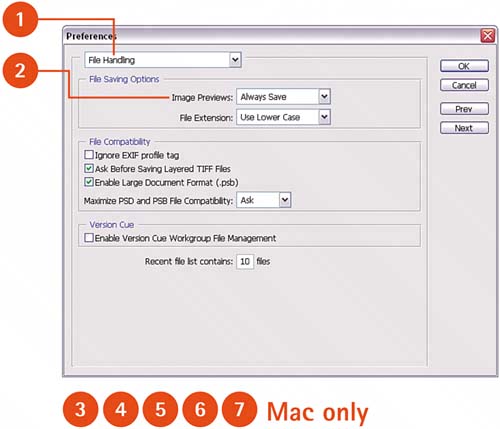
 Preferences Title pop-up menu: Click the arrow to display a list of other pages in the Preferences window; select an option to open that page. Currently it should be set to File Handling to view the options discussed here. Preferences Title pop-up menu: Click the arrow to display a list of other pages in the Preferences window; select an option to open that page. Currently it should be set to File Handling to view the options discussed here.
 Image Previews pop-up menu: Click the arrow to display a list of save options and then select one of these options: Always Save, Never Save, or Ask when Saving. Image Previews pop-up menu: Click the arrow to display a list of save options and then select one of these options: Always Save, Never Save, or Ask when Saving.
 Icon check box (Mac only): Saves an icon preview for viewing within windows on the desktop. Icon check box (Mac only): Saves an icon preview for viewing within windows on the desktop.
 Full Size check box (Mac only): Saves a 72dpi file version for applications that can open only low-resolution Photoshop files. Full Size check box (Mac only): Saves a 72dpi file version for applications that can open only low-resolution Photoshop files.
 Macintosh Thumbnail check box (Mac only): Creates a thumbnail that is displayed in Macintosh systems in the Open dialog box. Macintosh Thumbnail check box (Mac only): Creates a thumbnail that is displayed in Macintosh systems in the Open dialog box.
 Windows Thumbnail check box (Mac only): Creates a thumbnail that is displayed in Windows systems. Windows Thumbnail check box (Mac only): Creates a thumbnail that is displayed in Windows systems.
  Append File Extension pop-up menu (Mac only): Adds file extensions as a file is saved, based on the file format. Click the arrow to display a list including Always, Never, and Ask when Saving. Append File Extension pop-up menu (Mac only): Adds file extensions as a file is saved, based on the file format. Click the arrow to display a list including Always, Never, and Ask when Saving.
 Use Lower Case check box: Adds the file extension using lowercase letters. In Windows, the File Extension pop-up menu offers the choice between automatically adding extensions to filenames in Use Upper Case or Use Lower Case letters. Use Lower Case check box: Adds the file extension using lowercase letters. In Windows, the File Extension pop-up menu offers the choice between automatically adding extensions to filenames in Use Upper Case or Use Lower Case letters.
 Ignore EXIF Profile Tag check box: Does not apply the color tag when contained within Exchangeable Image File information. EXIF information is typically saved from digital camera settings, and some photographers prefer to disable the wide-gamut tags. Ignore EXIF Profile Tag check box: Does not apply the color tag when contained within Exchangeable Image File information. EXIF information is typically saved from digital camera settings, and some photographers prefer to disable the wide-gamut tags.
 Ask Before Saving Layered TIFF Files check box: Prompts to include additional save options when saving TIFF files after adding layers. Ask Before Saving Layered TIFF Files check box: Prompts to include additional save options when saving TIFF files after adding layers.
 Enable Large Document Format (.psb) check box: Enables Photoshop to recognize Large Document Format files, extending the maximum file dimensions to 300,000 X 300,000 pixels. If this check box is disabled, Photoshop defaults to a limit of 30,000 X 30,000 pixels. Enable Large Document Format (.psb) check box: Enables Photoshop to recognize Large Document Format files, extending the maximum file dimensions to 300,000 X 300,000 pixels. If this check box is disabled, Photoshop defaults to a limit of 30,000 X 30,000 pixels.
 Maximize PSD and PSB File Compatibility pop-up menu: Determines when and how Photoshop embeds a flattened version of the image within the file for compatibility with other software. Options in the pop-up menu are Ask, Always, and Never. Maximize PSD and PSB File Compatibility pop-up menu: Determines when and how Photoshop embeds a flattened version of the image within the file for compatibility with other software. Options in the pop-up menu are Ask, Always, and Never.
 Enable Version Cue Workgroup File Management check box: Turns on version-control capabilities for workgroup-based development. Enable Version Cue Workgroup File Management check box: Turns on version-control capabilities for workgroup-based development.
 Recent File List Contains field: Type a number in the box to set the number of recent files to be displayed in the Recent Files pop-up menu that appears when you select File, Open Recent. Recent File List Contains field: Type a number in the box to set the number of recent files to be displayed in the Recent Files pop-up menu that appears when you select File, Open Recent.
Display & Cursors Click the Next button to go to the Display & Cursors Preferences window or select Edit, Preferences, Display & Cursors to open the Preferences window to the Display & Cursors page (in Mac OS X, select Photoshop, Preferences, Display & Cursors). You use this page to specify brush and cursor shapes and sizes. 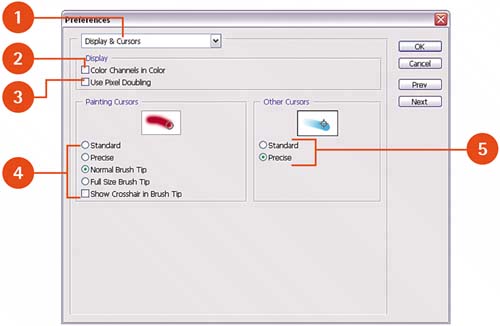  Preferences Title pop-up menu: Click the arrow to display a list of other pages in the Preferences box; select an option to open that page. Currently it should be set to Display & Cursors to view the options discussed below. Preferences Title pop-up menu: Click the arrow to display a list of other pages in the Preferences box; select an option to open that page. Currently it should be set to Display & Cursors to view the options discussed below.
 Color Channels in Color check box: Displays the color channels in color rather than in grayscale. Color Channels in Color check box: Displays the color channels in color rather than in grayscale.
 Use Pixel Doubling check box: Enables faster previews by temporarily reducing the resolution of the preview (it does not affect the actual file, only the preview). Use Pixel Doubling check box: Enables faster previews by temporarily reducing the resolution of the preview (it does not affect the actual file, only the preview).
 Painting Cursors radio buttons: You can select Standard (icon), Precise (cross hairs), Normal Brush Tip (actual shape and size of the brush tip), or Full Size Brush Tip (actual shape with visual indications of a soft or hard edge) for the painting cursor. In addition, a Show Crosshair in Brush Tip check box can be enabled along with either the Normal Brush Tip or Full Size Brush Tip options to see a crosshair inside the brush tip. Painting Cursors radio buttons: You can select Standard (icon), Precise (cross hairs), Normal Brush Tip (actual shape and size of the brush tip), or Full Size Brush Tip (actual shape with visual indications of a soft or hard edge) for the painting cursor. In addition, a Show Crosshair in Brush Tip check box can be enabled along with either the Normal Brush Tip or Full Size Brush Tip options to see a crosshair inside the brush tip.
 Other Cursors radio buttons: Enable you to select between a Standard (icon) and Precise (cross hairs) cursor for the nonpainting tools. Other Cursors radio buttons: Enable you to select between a Standard (icon) and Precise (cross hairs) cursor for the nonpainting tools.
Transparency & Gamut Click the Next button to go to the Transparency & Gamut Preferences window or select Edit, Preferences, Transparency & Gamut to open the Preferences window to the Transparency & Gamut page (in Mac OS X, select Photoshop, Preferences, Transparency & Gamut). You use this page to specify how transparency is shown in a file, as well as to select the gamut warning color format. 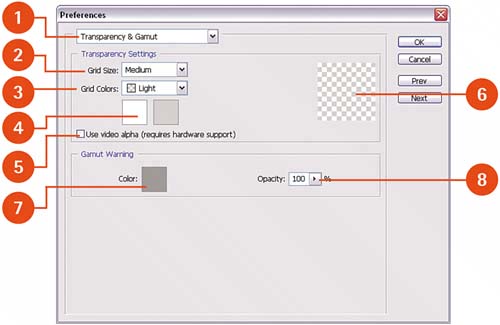  Preferences Title pop-up menu: Click the arrow to display a list of other pages in the Preferences window; select an option to open that page. Currently it should be set to Transparency & Gamut to view the options discussed here. Preferences Title pop-up menu: Click the arrow to display a list of other pages in the Preferences window; select an option to open that page. Currently it should be set to Transparency & Gamut to view the options discussed here.
 Grid Size pop-up menu: Controls the size of the checkerboard used to indicate transparency. Options are None, Small, Medium, and Large. Grid Size pop-up menu: Controls the size of the checkerboard used to indicate transparency. Options are None, Small, Medium, and Large.
 Grid Colors pop-up menu: Controls the color of the checkerboard used to indicate trans parency. Options are Light, Medium, Dark, Red, Orange, Green, Blue, Purple, and Custom. Grid Colors pop-up menu: Controls the color of the checkerboard used to indicate trans parency. Options are Light, Medium, Dark, Red, Orange, Green, Blue, Purple, and Custom.
 Custom color swatches: Click one or both of the swatches to select custom colors for the transparency checkerboard. Custom color swatches: Click one or both of the swatches to select custom colors for the transparency checkerboard.
 Use Video Alpha check box: Enables video alpha capability (a special effect transparency technique available with certain video boards). Use Video Alpha check box: Enables video alpha capability (a special effect transparency technique available with certain video boards).
 Transparency preview window: Shows the current checkerboard pattern. Transparency preview window: Shows the current checkerboard pattern.
 Gamut Warning Color swatch: Click to display the Color Picker so you can select the color that will show in place of the out-of-gamut color. Gamut Warning Color swatch: Click to display the Color Picker so you can select the color that will show in place of the out-of-gamut color.
 Gamut Warning Opacity slider: Click and drag the slider to control the transparency of the color you've chosen to replace the out-of-gamut color. Gamut Warning Opacity slider: Click and drag the slider to control the transparency of the color you've chosen to replace the out-of-gamut color.
Units & Rulers Select Edit, Preferences, Units & Rulers to open the Preferences window to the Units & Rulers page (in Mac OS X, select Photoshop, Preferences, Units & Rulers). You use this page to specify the format and measurements for rulers and columns. 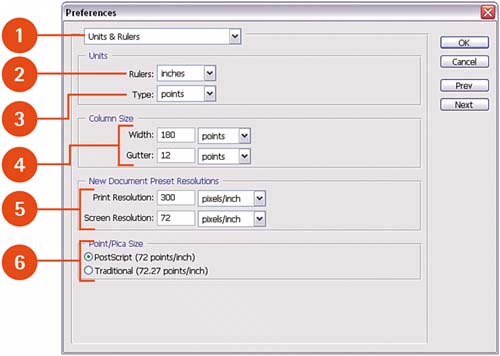  Preferences Title pop-up menu: Click the arrow to display a list of other pages in the Preferences window; select an option to open that page. Currently it should be set to Units & Rulers to view the options discussed here. Preferences Title pop-up menu: Click the arrow to display a list of other pages in the Preferences window; select an option to open that page. Currently it should be set to Units & Rulers to view the options discussed here.
 Rulers Units pop-up menu: Click the arrow to display a list of the units of measurement for Photoshop rulers. Options include Pixels, Inches, Centimeters, Millimeters, Points, Picas, and Percent. Rulers Units pop-up menu: Click the arrow to display a list of the units of measurement for Photoshop rulers. Options include Pixels, Inches, Centimeters, Millimeters, Points, Picas, and Percent.
 Type Units pop-up menu: Click the arrow to display a list of the units of measurement for type (text) specifications. Options include Pixels, Points, and Millimeters. Type Units pop-up menu: Click the arrow to display a list of the units of measurement for type (text) specifications. Options include Pixels, Points, and Millimeters.
 Column Size Width and Gutter pop-up menus: Enter the width of a target column and the width of the gutter (the space between columns) for layout purposes. When resizing an image or a canvas, the units you specify here are the ones you see when you select Columns in the New, Image Size, or Canvas Size dialog box. Column Size Width and Gutter pop-up menus: Enter the width of a target column and the width of the gutter (the space between columns) for layout purposes. When resizing an image or a canvas, the units you specify here are the ones you see when you select Columns in the New, Image Size, or Canvas Size dialog box.
 New Document Preset Resolutions fields: Pop-up menus control pixels per inch or centimeters. Enter default new document resolutions for print or screen in the fields. New Document Preset Resolutions fields: Pop-up menus control pixels per inch or centimeters. Enter default new document resolutions for print or screen in the fields.
 Point/Pica Size radio buttons: Select either the PostScript or the Traditional measurement system. Point/Pica Size radio buttons: Select either the PostScript or the Traditional measurement system.
Guides, Grid & Slices Click the Next button to go to the Guides, Grid & Slices Preferences window or select Edit, Preferences, Guides, Grid & Slices to open the Preferences window to the Guides, Grid & Slices page (in Mac OS X, select Photoshop, Preferences, Guides, Grids & Slices). You use this page to control interpolation and a number of other general application parameters. 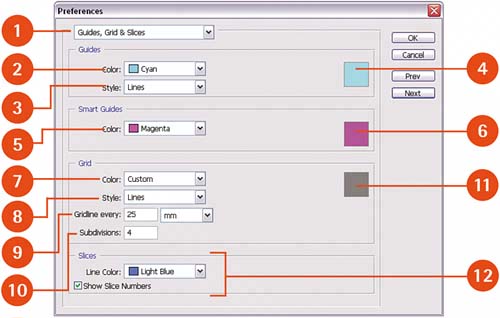  Preferences Title pop-up menu: Click the arrow to display a list of other pages in the Preferences window; select an option to open that page. Currently it should be set to Guides, Grid & Slices to view the options discussed here. Preferences Title pop-up menu: Click the arrow to display a list of other pages in the Preferences window; select an option to open that page. Currently it should be set to Guides, Grid & Slices to view the options discussed here.
 Guides Color pop-up menu: Select the color of the guide lines. Choices are Light Blue, Light Red, Green, Medium Blue, Yellow, Magenta, Cyan, Light Gray, Black, and Custom. Guides Color pop-up menu: Select the color of the guide lines. Choices are Light Blue, Light Red, Green, Medium Blue, Yellow, Magenta, Cyan, Light Gray, Black, and Custom.
 Guides Style pop-up menu: Determines the format of the guides. Options are solid Lines and Dashed Lines. Guides Style pop-up menu: Determines the format of the guides. Options are solid Lines and Dashed Lines.
 Guides color swatch: Click to open the Color Picker so you can select a custom guide color. Guides color swatch: Click to open the Color Picker so you can select a custom guide color.
 Smart Guides Color pop-menu: Select the color of the smart guide lines. Choices are Light Blue, Light Red, Green, Medium Blue, Yellow, Magenta, Cyan, Light Gray, Black, and Custom. Smart Guides Color pop-menu: Select the color of the smart guide lines. Choices are Light Blue, Light Red, Green, Medium Blue, Yellow, Magenta, Cyan, Light Gray, Black, and Custom.
 Smart Guides color swatch: Click to open the Color Picker so you can select a custom smart guide color. Smart Guides color swatch: Click to open the Color Picker so you can select a custom smart guide color.
 Grid Color pop-up menu: Select the color of the grid. Choices are Light Blue, Light Red, Green, Medium Blue, Yellow, Magenta, Cyan, Light Gray, Black, and Custom. Grid Color pop-up menu: Select the color of the grid. Choices are Light Blue, Light Red, Green, Medium Blue, Yellow, Magenta, Cyan, Light Gray, Black, and Custom.
 Grid Style pop-up menu: Determines the format of the grid. Options are solid Lines, Dots, and Dashed Lines. Grid Style pop-up menu: Determines the format of the grid. Options are solid Lines, Dots, and Dashed Lines.
 Gridline controls: Select the unit of measurement from the pop-up menu for the main grid divisions. Choices are Pixels, Inches, Centimeters, Points, Picas, and Percent. After you select a unit, type the number of units between gridlines. Gridline controls: Select the unit of measurement from the pop-up menu for the main grid divisions. Choices are Pixels, Inches, Centimeters, Points, Picas, and Percent. After you select a unit, type the number of units between gridlines.
 Subdivisions: Determines how many subdivisions fall between each main gridline. Enter the desired value in the field. Subdivisions: Determines how many subdivisions fall between each main gridline. Enter the desired value in the field.
 Grid color swatch: Click to open the Color Picker so you can select a custom grid color. Grid color swatch: Click to open the Color Picker so you can select a custom grid color.
 Slices options: Select slices line color from the Line Color pop-up menu. Choices are Light Blue, Light Red, Green, Medium Blue, Yellow, Magenta, Cyan, Light Gray, and Black. To show slice numbers, enable the Show Slice Numbers check box. Slices options: Select slices line color from the Line Color pop-up menu. Choices are Light Blue, Light Red, Green, Medium Blue, Yellow, Magenta, Cyan, Light Gray, and Black. To show slice numbers, enable the Show Slice Numbers check box.
Plug-ins & Scratch Disks Click the Next button to go to the Plug-ins & Scratch Disks Preferences window box or select Edit, Preferences, Plug-Ins & Scratch Disks to open the Preferences window to the Plug-Ins & Scratch Disks page (in Mac OS X, select Photoshop, Preferences, Plug-ins & Scratch Disks). You use this page to tell Photoshop where to look for plug-ins and scratch disks. Plug-ins are utilities and filters that extend Photoshop's core functionality. The default Photoshop plug-ins folder is located under the main Photoshop directory; install any plug-ins there. However, for sharing with other applications or housekeeping purposes, you might want to use a separate folder for any third-party plug-ins. This page of the Preferences window enables you to specify an additional folder for Photoshop to access. As Photoshop manipulates files, it temporarily appropriates hard disk space to free up RAM memory. When you work with larger files, it's even more important to have free disk space for the scratch disk. This page of the Preferences box is also the place for you to tell Photoshop which drives to use for the scratch disk. 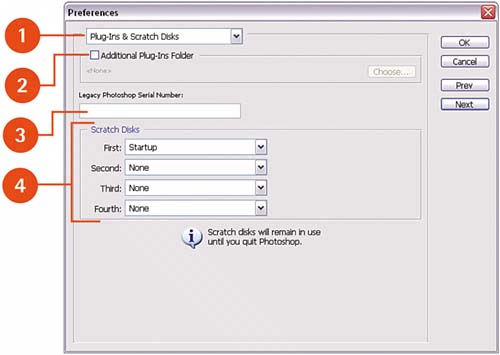  Preferences Title pop-up menu: Click the arrow to display a list of other pages in the Preferences window; select an option to open that page. Currently it should be set to Plug-Ins & Scratch Disks to view the options discussed here. Preferences Title pop-up menu: Click the arrow to display a list of other pages in the Preferences window; select an option to open that page. Currently it should be set to Plug-Ins & Scratch Disks to view the options discussed here.
 Additional Plug-ins Folder check box and Choose button: Enable the check box and click Choose to navigate to an additional plug-ins folder. Additional Plug-ins Folder check box and Choose button: Enable the check box and click Choose to navigate to an additional plug-ins folder.
 Legacy Photoshop Serial Number field: Enter the old-style Photoshop serial number in the field as required by certain plug-ins. Legacy Photoshop Serial Number field: Enter the old-style Photoshop serial number in the field as required by certain plug-ins.
 Scratch Disks pop-up menus: Click to select up to four disks that will serve as scratch disks. All mounted disks are listed as scratch disk options. You might need more than one scratch disk if you work with particularly large image files. Scratch Disks pop-up menus: Click to select up to four disks that will serve as scratch disks. All mounted disks are listed as scratch disk options. You might need more than one scratch disk if you work with particularly large image files.
Memory & Image Cache Click the Next button to go to the Memory & Image Cache Preferences window or select Edit, Preferences, Memory & Image Cache to open the Preferences window to the Memory & Image Cache page (in Mac OS X, select Photoshop, Preferences, Memory & Image Cache). You use this page to allocate RAM to the application and to set the number of caching levelsa Photoshop method for speeding screen redraw. 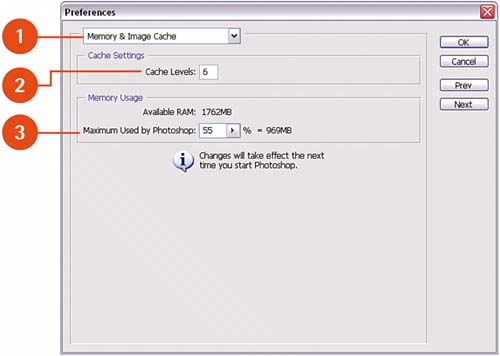  Preferences Title pop-up menu: Click the arrow to display a list of other pages in the Preferences window; select an option to open that page. Currently it should be set to Memory & Image Cache to view the options discussed here. Preferences Title pop-up menu: Click the arrow to display a list of other pages in the Preferences window; select an option to open that page. Currently it should be set to Memory & Image Cache to view the options discussed here.
 Cache Levels field: Enter the number of cache levels you want to use. A higher number speeds redraws but requires more RAM and can increase the time it takes to open an image. Cache Levels field: Enter the number of cache levels you want to use. A higher number speeds redraws but requires more RAM and can increase the time it takes to open an image.
 Memory Usage/Maximum Used by Photoshop: Allocates the percentage of available memory (shown as available RAM) to be used by Photoshop. The slider control allocates from 36MB to 100% of available memory. Memory Usage/Maximum Used by Photoshop: Allocates the percentage of available memory (shown as available RAM) to be used by Photoshop. The slider control allocates from 36MB to 100% of available memory.
Type Click the Next button to go to the Type Preferences window or select Edit, Preferences, Type to open the Preferences window to the Type page (in Mac OS X, select Photoshop, Preferences, Type). You use this page to turn on smart quotes and customize how the type options look. 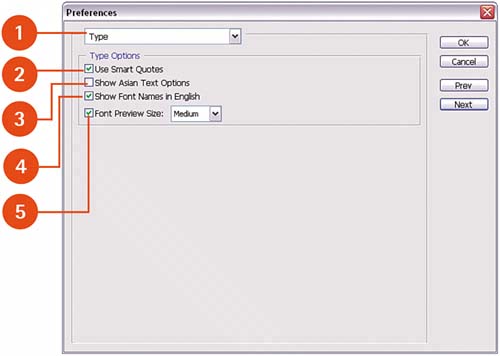  Preferences Title pop-up menu: Click the arrow to display a list of other pages in the Preferences window; select an option to open that page. Currently it should be set to Type to view the options discussed here. Preferences Title pop-up menu: Click the arrow to display a list of other pages in the Preferences window; select an option to open that page. Currently it should be set to Type to view the options discussed here.
 Use Smart Quotes check box: Uses curly quotes (quotation marks that curl in on both ends of a sentence) instead of straight quotes. Use Smart Quotes check box: Uses curly quotes (quotation marks that curl in on both ends of a sentence) instead of straight quotes.
 Show Asian Text Options check box: Displays text options for installed Asian character sets in the character and paragraph text palettes. Show Asian Text Options check box: Displays text options for installed Asian character sets in the character and paragraph text palettes.
 Show Font Names in English check box: Displays Asian font names in English. Show Font Names in English check box: Displays Asian font names in English.
 Font Preview Size check box and pop-up menu: Determine the size of the font preview on the Type tool Options bar and the Character palette. Select from Small, Medium (the default), or Large. Font Preview Size check box and pop-up menu: Determine the size of the font preview on the Type tool Options bar and the Character palette. Select from Small, Medium (the default), or Large.
|










